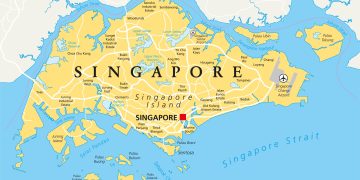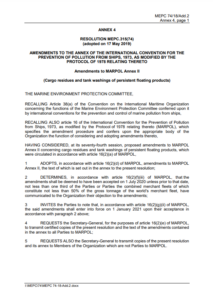IMO’s MEPC 74 in May adopted resolution MEPC.315(74), amending regulations 1, 13, appendix IV and appendix VI of MARPOL Annex II concerning cargo residues and tank washings of persistent floating products with a high viscosity and/or high melting point in specific areas. The amendments are expected to be entered into force on 1st January 2021.
Amendments
- Regulation 1 – Definitions (Chapter 1)
A new paragraph 23 is added as follows:
“23 Persistent floater means a slick forming substance with the following properties:
– Density: ≤ sea water (1025 kg/m3 at 20°C);
– Vapour pressure: ≤ 0.3 kPa;
– Solubility: ≤ 0.1% (for liquids) ≤ 10% (for solids); and
– Kinematic viscosity: > 10 cSt at 20°C.”
- Regulation 13 – Control of discharges of residues of noxious liquid substances (Chapter 5)
-A new paragraph 7.1.4 is inserted after existing paragraph 7.1.3 as follows:
“7.1.4 For substances assigned to category Y that are persistent floaters with a viscosity equal to or greater than 50 mPa×s at 20ºC and/or with a melting point equal to or greater than 0ºC, as identified by ‘16.2.7’ in column ‘o’ of chapter 17 of the IBC Code, the following shall apply in the areas in paragraph 9:
- a prewash procedure as specified in appendix VI to this annex shall be applied;
- the residue/water mixture generated during the prewash shall be discharged to a reception facility at the port of unloading until the tank is empty; and
- any water subsequently introduced into the tank may be discharged into the sea in accordance with the discharge standards in regulation 13.2.“
-A new paragraph 9 is inserted after existing paragraph 8.2 as follows:
9. Areas to which regulation 13.7.1.4 applies
9.1. the North West European waters include the North Sea and its approaches, the Irish Sea and its approaches, the Celtic Sea, the English Channel and its approaches and part of the North East Atlantic immediately to the west of Ireland.
9.2. the Baltic Sea area means the Baltic Sea proper with the Gulf of Bothnia, the Gulf of Finland and the entrance to the Baltic Sea bounded by the parallel of the Skaw in the Skagerrak at 57°44.8′ N;
9.3. the Western European waters is an area that covers the UK, Ireland, Belgium, France, Spain and Portugal, from the Shetland Islands in the North to Cape S. Vicente in the South, and the English Channel and its approaches.
9.4. the Norwegian Sea
(See the exact points of application in the circular below)
- APPENDIX IV – Standard Format For The Procedures And Arrangements Manual
Section 4 – Procedures relating to the cleaning of cargo tanks, the discharge of residues, ballasting and deballasting
4. Paragraph 4.4.5 is replaced by the following:
“5. Persistent floaters with a viscosity equal to or greater than 50 mPa×s at 20ºC and/or a melting point equal to or greater than 0ºC This section should contain instructions on how to deal with tank washings of substances identified by the presence of ‘16.2.7’ in column ‘o’ of chapter 17 of the IBC Code and the latest version of the MEPC.2/Circular, when operating in the areas specified in regulation 13.9 of Annex II.”
Addendum A – Flow diagrams – Cleaning of cargo tanks and disposal of tank washings/ballast containing residues of category X, Y and Z substances
5. A new Note 4 is inserted after existing Note 3 as follows:
“Note 4: Within the areas specified in regulation 13.9 of Annex II, regulation 13.7.1.4 applies to substances that are identified by ‘16.2.7’ in column ‘o’ of chapter 17 of the IBC Code.”
- APPENDIX VI – Prewash procedures
6. A new section C is added after existing paragraph 21 as follows:
“C For all ships
Prewash procedures for persistent floaters to which regulation 13.7.1.4 of Annex II of MARPOL applies
Persistent floaters with a viscosity equal to or greater than 50 mPa×s at 20ºC and/or a melting point equal to or greater than 0ºC, shall be treated as solidifying or high-viscosity substances for the purposes of the prewash.
Where it is determined that the use of small amounts of cleaning additives would improve and maximize the removal of cargo residues during a prewash, then this should be done in consultation and with prior agreement from the reception facility.”
Explore more in the official IMO circular herebelow:
See also:
































































